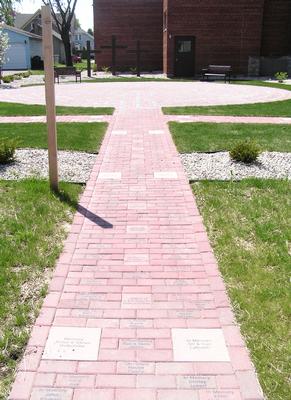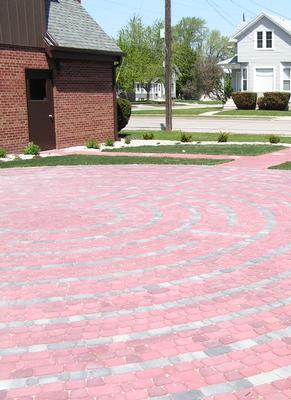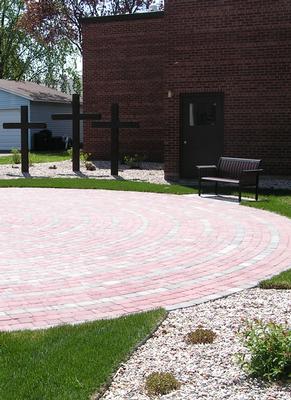labyrinth
Labyrinth have been a part of virtually every know religious tradition. They have been found on every continent and in every nation. It is impossible to determine when the first labyrinths appeared, but the oldest remaining labyrinth is found in modern day Turkey and is dated to more than 6,000 years ago. Labyrinths that have not survived into modern times may have been in use for much longer. Archaeologists have cataloged more than 19,000 different labyrinths (and still counting), and they appear in amazing varieties. Some are small, located on pottery or vases, and designed to be traced by people's fingers. Some are massive, larger than football fields, using living shrubs or hedges to identify the pathway. The ancient Chinese tended to prefer half circle shaped labyrinths. The Romans preferred labyrinths laid out in squares. The oldest remaining Christian labyrinth is located in modern Syria and was produced in the early 300's. Our labyrinth is a variation of the best know Christian labyrinth of the Middle Ages, found in the Cathedral of Notre Dame de Chartres in France. It s composed on 11 circuits divided into 4 quadrants. It may not be easy to recognize, but the four quadrants form a cross. The center area serves as a place to stop, pray, meditate and reflect on what you may have "received" on the first part of the journey.
Our lives are sacred journeys in which we encounter joy, sorrow, growth, defeat grief, celebrations, changes, and all the other experiences that challenge and transform our understanding of life. The labyrinth functions as a meditation or prayer tool to help us focus and encounter the sacredness of our changing life.
A labyrinth has no dead ends or puzzles to be solved. (If it did, it would be recognized as a maze.) A labyrinth has one path IN and the same path OUT. Walking a labyrinth is not as task. It is an invitation to use our gifts of creativity, imagination and receptiveness to the presence of all that his holy in our life.
The journey takes us inward toward our center and then back out into the word with new insights into ourselves and God's presence. It is not magic. It is like a prayer in motion, through which we may receive guidance, new questions, or simply silence and peace.
The presence of a labyrinth in a Christian setting may be new for many people even though it is an ancient sacred symbol used by all spiritual traditions. Christian labyrinths seem to have been in use very early in the history of the Church, but their use grew dramatically around the 1200's following the Crusades. When Christians tried to claim the Bible lands as Christian territory, they were successful in capturing Jerusalem in 1096AD. It then became a "spiritual obligation" that a "faithful Christian" would take at least one "pilgrimage journey" to Jerusalem during their lifetime. But when the Christians were pushed out of the Bible lands around the year 1200, it became impossible to fulfill this pilgrimage obligation. In place of the pilgrimage to Jerusalem, Christian churches in Europe and other regions began to use labyrinths as a tool for spiritual pilgrimages. Many of the great historical cathedrals had labyrinths built directly into the floors of the cathedrals (pews were not yet in used, so the labyrinths were much more visible). The practice tended to fade by the early 1700's, but with the business of people's lives, in modern times, there has been a spiritual awakening and a desire for labyrinths across the world. In Wisconsin alone, there have been over 300 different kinds of labyrinths build in various communities in the past 20 years.
This is a common question. Just as prayer is individual, so is walking the labyrinth. There is no right or wrong way. Just remember it is not a race. In the business of lives, we tend to try to do things quickly, even making prayer something that we squeeze into a minute or two between other activities. Walking a labyrinth is a longer time of more concentrated and focused prayer. It is not a task to be completed. It is intended to be a time of reflection and openness to the presence of God. Some people remove their shoes while walking so they can feel the "ground" it brings them, but this is not necessary with an outdoor labyrinth.
As you stand at the entrance, take a deep breath and allow yourself to feel surrounded by God's presence. Relax and take the first step. The full journey in and out may take 20 minutes or more than an hour. If someone else is walking at the same time as you, you may need to step aside to let each other pass. If you smile, make eye contact, or laughter, consider it a blessing.
When you reach the center, you may want to sit or stand for a while, again opening yourself to insights that might come to you. On your journey out, you may feel differently, or you may feel as if nothing has changed. Some people only sense that something has happened to them, after reflecting a while, or several days. For some people, it may take several journeys on the labyrinth to sense the gifts it has to offer.
You have a question. It might be work, relationships, a loss, a major life change, or questions of faith? As you walk the labyrinth listen within your heart and mind for wisdom. Be aware that it may not come as concretely as you expect.
You seek inner peace. Center yourself on what is troubling you. Pay attention to your breathing. The biblical word for Spirit is breath. Allow God's spirit (breath) to fill you, and offer you peace as you exhale and cast off what is your trouble.
You may want to commune more closely with God. On your pathway into the labyrinth try to let go of all that distracts you. Open yourself to God's presence and receive what comes with an open heart and mind. At the center stop and pray. Let your own heart determine when it is time to walk the pathway out, but know that God walks with your life's journey too.
Use this time to pray for yourself or someone else: to give thanks or to praise God. Some people may wish to write down their prayer request on paper. In the mail-box we have placed pencils and small envelopes.
Some people find it helpful to repeat a meaningful phrase, such as a quote from scripture, a line from a hymn, poetry or an insight you have recently received, or even a single word. Just remember the focus is not on what you are saying, but what God may be saying to you.
Here are some examples:
Peace.
Patience.
The Lord is my shepherd.
God of love, fill me with your presence.
Jesus, Son of God, have mercy on me.
God above me, beside me, with in me.
If you receive another word or phrase while walking, be glad for the gift it is.
Suggested Readings:
Walking the Sacred Path by Dr Lauren Artress
Living the Labyrinth by Jill K.H. Geoffrion
Labyrinths & Mazes by Jeff Saward
You may also wish to look at the names on the pathways leading to the labyrinth. It is through gifts in memory or honor of these person and families that the funding for the labyrinth was completed. If you know one or more of these persons, or if you note the name of a stranger, you might wish to offer a prayer on their behalf.
Also feel free to find rest on the benches that are provided.
to DC Stoneworks of Oshkosh, who offered excellent craftsmanship in building the labyrinth and completing the project in a manner and cost that allowed our church to offer this meditative prayer area to the community.
It's sad that we live in a world where this is necessary, but we need to express that all people are welcome to walk and pray in this area, but Emmanuel Church accepts no responsibility if someone should stumble, fall or be hurt while walking in this area.
"To walk a labyrinth is to touch God, and let God touch us."



